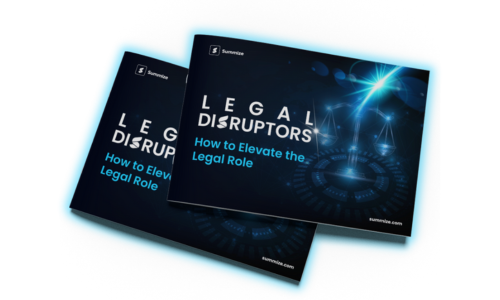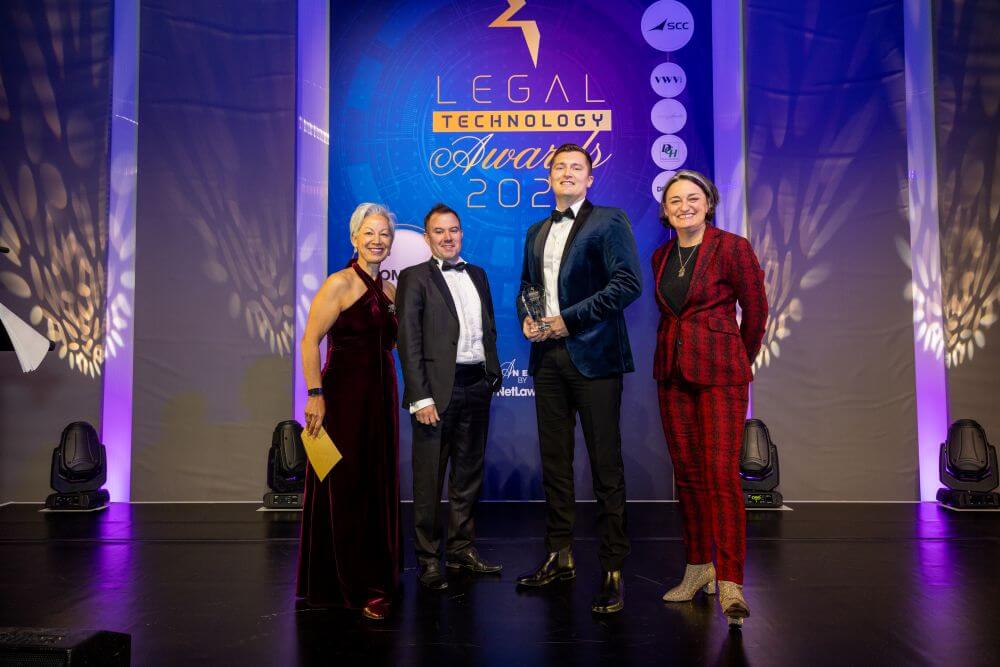Exploring legal innovation across the corporate world
The legal industry might have taken longer to catch up on innovation, but now, legal teams that refuse to innovate will fall behind their counterparts.
March 1, 2021
December 19, 2025
Innovation has been embedded within the corporate world. It’s become part of how we think, and it informs our cultural understanding of what productive, energetic companies look like. As market competition continues to rise, it becomes clear that businesses who refuse to innovate will fail.
The legal industry might have taken longer to catch up with this phenomenon, but we are now seeing rapid change in a sector that has, at times, been reluctant to leave its traditional structures.
What is true innovation?
Innovation is changeable, in the sense that every business and sector will have its own unique take on the concept. Looking within legal, Brian Kuhn of Elevate Services said:
“One of the things that we're seeing in the legal industry is that technology is becoming better. It's a simple truth. It's also getting cheaper and therefore more accessible, and that's good news. But in some ways, it makes innovation more difficult because it can lead to analysis paralysis.”
This “analysis paralysis” is a real issue and can put a serious hold on innovation. However, it can be avoided if businesses take the time to address their own specific objectives.
“Your needs are uniquely your own, and software still tends to be made in the ‘one-size-fits-all' way. Thankfully, that’s now changing. The real force of innovation is how you apply these technologies in the right way to your specific business problems. It's not about having the technology; it's how you apply it. And there's as much an art to that as there is a science. And the art part is not technology-based at all, it's looking at your business’ problems? It's about delving into the core of your business, considering its values, responsibilities, and impact on society. By incorporating the principles of corporate citizenship, you can align your innovative strategies with ethical practices and contribute to the greater good.”
Identifying the problem should always be the starting point and as Brian says, shouldn’t be solely focused on technology. Niti Nadarajah, a senior in-house lawyer in Australia points out,
“Quite often when we talk about innovation and the law, we immediately jump to technological innovation. But, at its most fundamental, innovation is simply about applying new ideas, methods or processes to something that is well established. Technology is just one part of that.”
The perception of innovation as an elusive concept, or something intangible that we feel we should be doing has been a drawback within legal. However, as Lisa Lang, General Counsel at KSU points out, 2020 has forced us to change our thinking,
“If you take the definition of innovation to be a change or something that is new, I don't think we have any choice (especially given our current times) other than to do things in a different way. Partly because we're now working in remote locations and a lot of the things that we did before we now can't do. We are changing because we have no choice but to change.”
But in the future, what should be prioritized for innovation within legal? Should it center around a product or a service? Elliot Leibu, co-host of the Legal Ops podcast, said: “We won't necessarily try to package up legal service as a product, but what we want to do is provide a service that helps lawyers be more efficient.”
While innovation sometimes relies on new ways of doing things, it doesn’t necessarily mean that we need to forget older or existing ways of working. In fact, as Elliot points out, we are increasingly seeing the layering of new tech on top of existing applications and processes; “There is the old and new coming together and Law is a perfect place for that to happen. It is full of archaic traditions and archaic rules and just in the last ten years or so, we’re being sort of dragged into the new world.”
Whether these changes are largely driven by external forces is, to some degree, irrelevant, as we are now in a position where legal has been outpaced by its environment. Technology is pervasive and the survival of businesses is dependent upon seamless remote working, connectivity and communication.
Technology and design: predictable partners
Technology has become synonymous with innovation, but which is easier to change, product or process, and which takes priority for legal teams? Do we focus too much on technology, and do we risk losing the human element by doing so?
Looking at this from an in-house perspective, Niti believes that identifying where tech slots into our new legal world has to be the starting point, and understanding that role will be key to the overall provision of legal services in the future; “Technology needs to become a part of how we provide legal services, enabling us to focus less on repetitive tasks and more on becoming strategic partners to the business, lawyers who are not just lawyers but advisers as well.”
In her role as GC, Lisa feels that there is absence of innovation within the world of in-house, simply because the corporate sector is often overlooked; moreover, she believes that some responsibility lies with lawyers themselves, “as lawyers, sometimes we have a tendency to be very transactional, and we focus on the work that we need to do and not the processes by which we do our work.” This is a key distinction. Law and lawyers are not one and the same and, by analogy, the substance of legal work should not be confused with the processes engaged to carry out that work. For example, contracts may not be shrinking any time soon, but the speed at which they can be reviewed is changing, thanks to tech tools and a shift in thinking around the process itself.
Retaining focus more on those processes will unlock further change within the profession, particularly if design thinking is embraced within the industry. Sticking to the world of contracts, how does design further ameliorate this process? Elliot has a few thoughts on this amalgam of tech and design; “If you're writing a contract for example, and you think carefully about how to try to make the contract as intelligible, clear and easy to understand as possible, are you engaging design? Well, arguably you are to some extent… design, what is it about if not making things human centred and digestible? That's obviously a broad view of it. But if you think about the legal market in general, we are seeing so many great new technologies come on the market that are built around user experience, a nice user interface and design first principles.”
Building upon this, Brian further stresses the importance of placing the customer at the center of any innovative journey, “innovation is really about meeting the needs of customers while solving your business problems as effectively as possible. The most innovative thing I think people can do right now is asking their end users what they want and what they need rather than assuming.”
It might sound obvious, but it will simply be an exercise in futility if we innovate without asking the customer what they want, how they want it to look/feel and why they want it in the first place. Overall, asking the right questions saves time and money in the long run; “Good user experience design reduces the cost of software development by 30 to 50% because you don't have to go back. If it doesn't meet the need, if it the form doesn't follow a function you don't have to go back and fix it so it reduces the cost. It also reduces the time by about a third.”
Despite these persuasive statistics, legal has been slower to adopt these concepts (user experience and design thinking), which Brian finds counterintuitive, particularly, for a services industry, “These are the things, without question, that are adding the most value, the most competitive value, and that are creating those valuable offerings. Whether you're a law firm and you want to augment your services, or you're a tech company and you're looking to create a new asset.”
Karen Bexley, CEO & Co-founder at Bexley Beaumont, recognizes the importance of technology, but strongly feels that the client must be the focus of any innovation, with technology working for both client and lawyer in the background, “it's much more about knowing the business, knowing the clients, knowing the person…because you're delivering and helping that person deliver their personal and their business goals.”
How do we embed change?
Changes in mindset need to start with academia if we are going to see embedded innovation. Niti also believes that “the law needs simplification. We should also learn to tailor our communications to our audience, not everyone thinks in words, some people are visual thinkers. We need to invest in creativity, in both sides of our brain. Not easy in a profession that is bound up in precedent and statute but I believe it can be done. For example, can we use story-telling to convey our messages? Or use visual medium like flowcharts, graphs, infographics to provide advice. We need to move away from a cookie-cutter approach to legal advice.”
Diversity of thinking and skill set has been the focus of much attention, but whether the practice reflects the concept is still unclear. Lisa believes that academia doesn’t fully prepare our future lawyers for the reality of practice, “Learning how to be commercially aware and being a business partner, is not something that's taught in law schools. A lot of lawyers who start out in big law and in law firms, really struggle with that concept when they come over to an in-house counsel setting.”
Moreover, Lisa believes that we could be truly missing out by failing to learn from those law students and junior lawyers who proffer a different skillset and way of thinking, “I do think that we more seasoned and experienced lawyers need to understand and appreciate that we have generations that are coming in after us that have been raised in a different technological world that we have been and that they have really got some insights. I think it's important for us to mentor younger lawyers but I think we also have to be open to the concept of a reverse mentorship, where we are open to them and their ideas.”
What does the future look like?
Clearly a massive, and complex, question, but we have already witnessed an acceleration of innovation and tech adoption that is unprecedented; so, what can we expect, or indeed hope, to see in the next few years?
Niti would like to see mindset changes within legal culture, “My hope is that, in time, we can really change this perception of the legal industry, and that innovation and the law, can become, if not synonymous with one another, then at least harmonious with each other.” Lisa is equally keen to see harmony and interplay between academia and practice, and between innovation and technology, although she cautions that we are not yet “seeing innovation and technology really being incorporated into the education preparation program for potential lawyers” in the US. Karen would like to see more “more genuine choices for clients and lawyers”, which was ultimately the driving force behind founding an innovative law firm.
There is a recognition that the future of legal will rest on how well we can pull together these different strands, from academia to practice, from design to tech solutions. Elliot predicts that a myriad of factors will mold the profession in the coming years; “The infiltration of design, process, change management, methodologies into legal, in a way that is recognized as being important and takes into account the special needs of lawyers, both in terms of the way we work and the kinds of people we are…I think that's going to continue to grow. And again, that'll only serve the profession well in the future.”
Moving from interplay to interoperability, Brian sees the latter as the future of legal, “There are platforms that have many different solutions and they all talk to each other on the same platform. In our industry you can have lots of great technology but it's not always compatible, and that creates a real barrier to innovation because it becomes more difficult to extract insight from all those different tools and then synthesize insights from them and see what you can learn across those tools. Now, that's the next big leap that, well, has happened in other industries already.”
Know your 'why'
Gary Hanel famously stated, “Out there in some garage is an entrepreneur who’s forging a bullet with your company’s name on it. You’ve got one option now – to shoot first. You’ve got to out-innovate the innovators”
If you don’t want to be out-innovated, some pretty succinct advice from Brian:
“The one thing I would like to see is a digital strategy before you buy technology so that it doesn't become an experiment. Before you invest in hiring developers to create something for you in-house or before you hire a software company to develop something for you. Know why, know your why.”
It’s a simple message that cuts through a lot of noise on innovation right now. Know your why. Develop a strategy around your why.
To hear even more of our insights and useful guidance for any in-house legal professional, explore our wide range of articles.
Discover even more!
Explore more about contracting and CLM in our ultimate contract guides








